Mr Hosken has lived in Siddington, Cirencester for the past few years and has combined his love of walking and cycling with his computer skills to produce a website about his many interests. One page is about The Obelisk and Roman Amphitheatre and he has kindly allowed AQIVA to publish his findings on our site.
Prepare for Mr Hosken’s guided trip around the Amphitheatre complex, where he has included the text from the information boards alongside his own comments.
The Obelisk and Roman Amphitheatre in Cirencester
The Obelisk Garden is adjacent to the Scout Hut car and bicycle park at the east end of Cotswold Avenue, GL7 1XW, conveniently approached via Chesterton Lane and then either Mount Street or Somerford Road.
Cirencester Obelisk
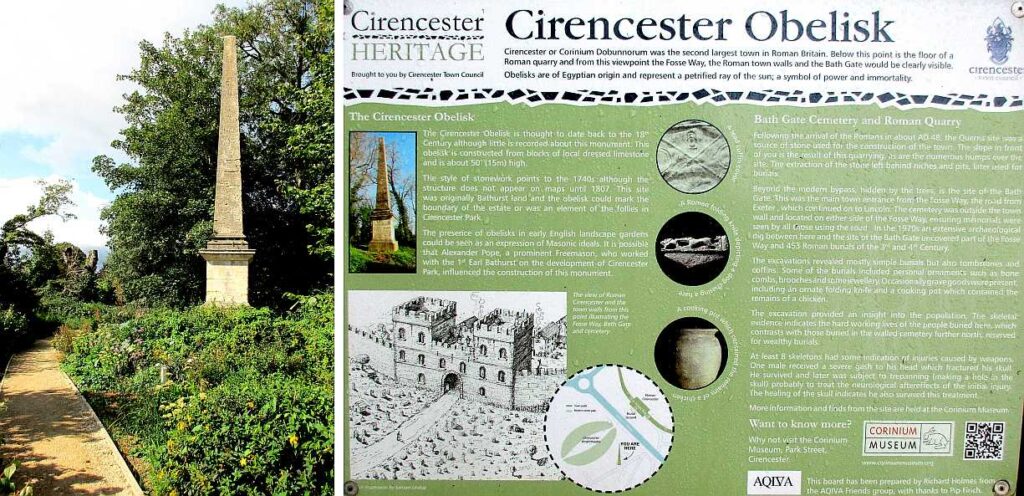
Images © Corinium Museum
Cirencester or Corinium Dobunnorum was the second largest town in Roman Britain. Below this point is the floor of a Roman quarry and from this point the Fosse Way, the Roman town walls and the Bath Gate would be clearly visible.
Obelisks are of Egyptian origin and represent a petrified ray of the sun, a symbol of power and immortality.
The Cirencester Obelisk is thought to date back to the 18th Century although little is recorded about this monument. This obelisk is constructed from blocks of local dressed limestone and is about 50 feet (15 metres) high. The style of stonework points to the 1740s although the structure does not appear on maps until 1807. This site was originally Bathurst land and the obelisk could mark the boundary of the estate or was an element of the follies in Cirencester Park. The presence of obelisks in early English landscape gardens could be seen as an expression of Masonic ideals. It is possible that Alexander Pope, a prominent Freemason, who worked with the 1st Earl Bathurst on the development of Cirencester Park, influenced the construction of this monument.
Bath Gate Cemetery and Roman Quarry
Following the arrival of the Romans in about AD 48, the Querns site was a source of stone used for the construction of the town. The slope in front of you is the result of this quarrying as are the numerous humps over the site. The extraction of the stone left behind niches and pits, later used for burials.
Beyond the modern bypass, hidden by the trees, is the site of the Bath Gate. This was the main town entrance from the Fosse Way, the road from Exeter, which continued on to Lincoln. The cemetery was outside the town wall and located on either side of the Fosse Way, ensuring memorials were seen by all those using the road. In the 1970s an extensive archaeological dig between here and the site of the Bath Gate uncovered part of the Fosse Way and 453 burials of the 3rd and 4th Century.
The excavations revealed mostly simple burials but also tombstones and coffins. Some of the burials included personal ornaments such as bone combs, brooches and some jewellery. Occasionally grave goods were present, including an ornate folding knife [illustrated] and a cooking pot [illustrated] that contained the remains of a chicken.
The excavation provided an insight into the population. The skeletal evidence indicates the hard working lives of the people buried here, which contrasts with those buried in the walled cemetery, reserved for wealthy burials. At least 8 skeletons had some indications of injuries caused by weapons. One male received a severe gash to his head which fractured his skull. He survived and later was subject to trepanning (making a hole in the skull) probably to treat the neurological aftereffects of the initial injury. The healing of the skull indicates that he also survived this treatment.
More information and finds from the site are held in the Corinium Museum, Park Street, Cirencester.
Meanwhile, a continuation of the footpath leads to the Roman Amphitheatre site, the first feature of which is the context map.
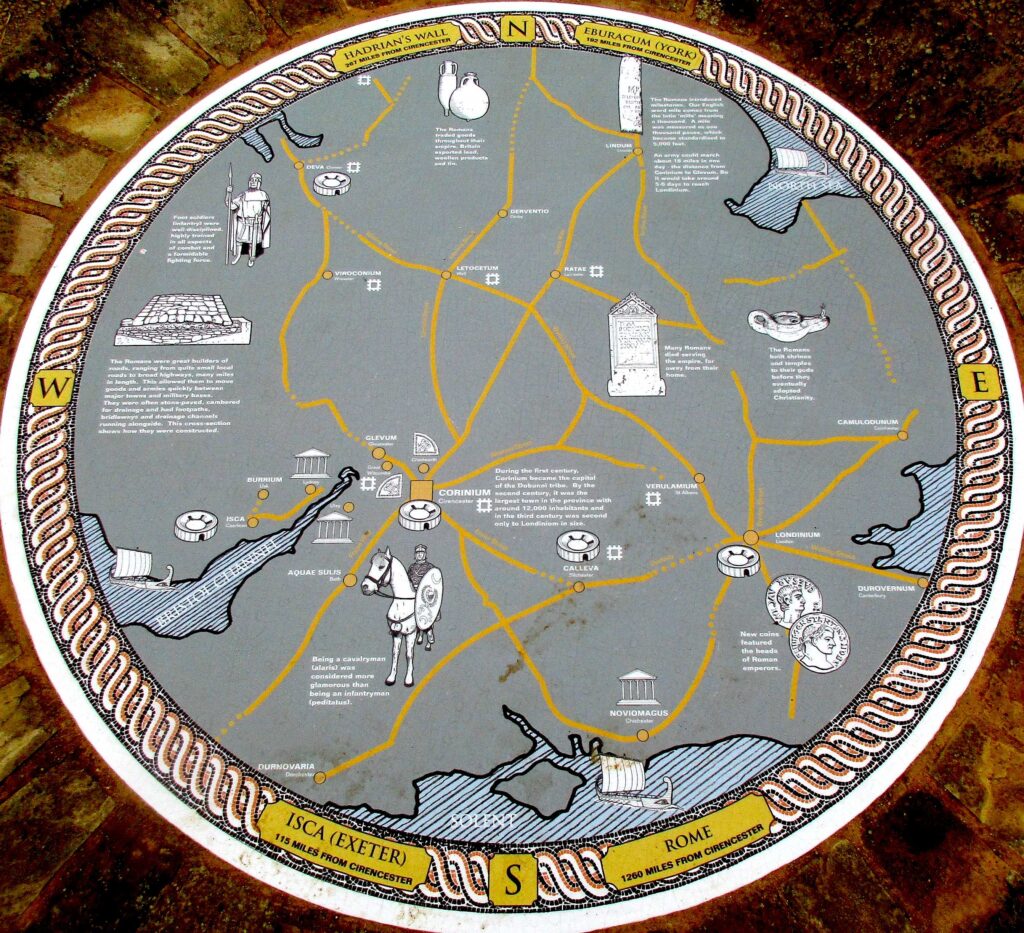
• The Romans introduced milestones. Our English word miles comes from the Latin ‘mille’ meaning a thousand. A mile was measured as one thousand paces, which became standardised to 5,000 feet. An army could march about 18 miles in one day – the distance from Corinium to Glevum, so it would take 5-6 days to reach Londinium.
• The Romans traded goods throughout their empire. Britain exported lead, woollen products and tin.
• Foot soldiers (infantry) were well disciplined, highly trained in all aspects of combat and a formidable fighting force.
• The Romans were great builders of roads, ranging from quite small local roads to broad highways, many miles in length. This allowed them to move goods and armies quickly between major towns and military bases. They were often stone-paved, cambered for drainage and had footpaths, bridleways and drainage channels running alongside. The cross-section diagram shows how they were constructed.
• Many Romans died serving the empire, far away from their home.
• The Romans built shrines and temples to their gods before they eventually adopted Christianity.
• During the first century, Corinium became the capital of the Dobunni tribe. By the second century, it was the largest town in the province with around 12,000 inhabitants, and in the third century was second only to Londinium in size.
• Being a cavalryman (alaris) was considered more glamorous than being an infantryman (peditatus).
• New coins featured the heads of Roman emperors.
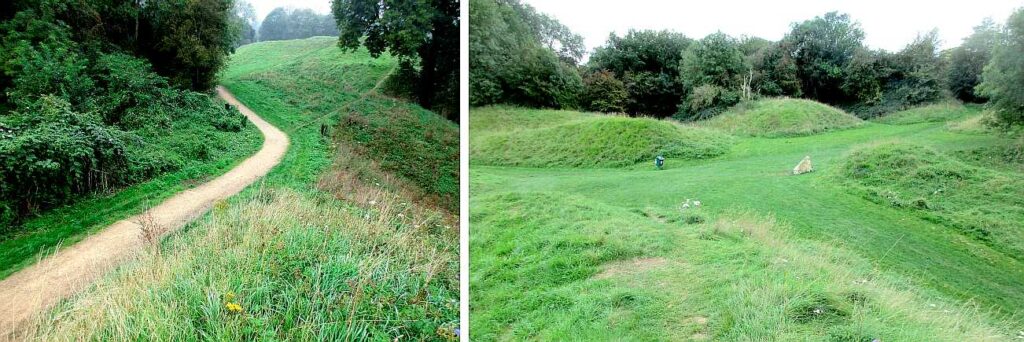
Images © Mike Hosken
Access to the amphitheatre itself is via the gravelled and grassed footpath.

Images © Mike Hosken
Unfortunately, photographs cannot convey the three-dimensional ups and downs and round-abouts of the Roman structure. A personal site visit is much the best option, exploring the mown areas and perhaps venturing along the unofficial ridge paths to look down from the once-upon-a-time standing-only tiers.
Entertaining Corinium
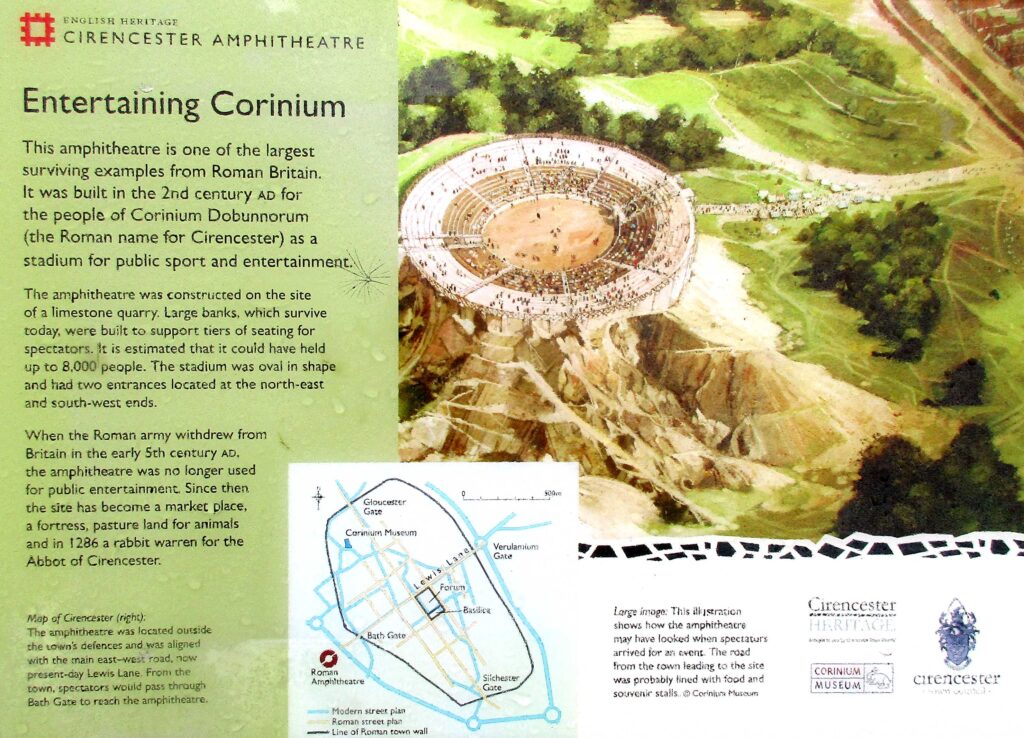
Images © Corinium Museum
This amphitheatre is one of the largest surviving examples from Roman Britain. It was built in the 2nd century AD for the people of Corinium Dobunnorum (the Roman name for Cirencester) as a stadium for public sport and entertainment.
The amphitheatre was constructed on the site of a limestone quarry. Large banks, which survive today, were built to support tiers of seating for spectators. It is estimated that it could have held up to 8,000 people. The stadium was oval in shape and had two entrances located at the north-east and south-west ends.
When the Roman army withdrew from Britain in the early 5th century AD, the amphitheatre was no longer used for public entertainment. Since then the site has been a market place, a fortress, pasture land for animals and in 1286 a rabbit warren for the Abbot of Cirencester.
Map of Cirencester
The amphitheatre was located outside the town’s defences and was aligned with the main east-west road, now present-day Lewis Lane. From the town, spectators would pass through Bath Gate to reach the amphitheatre.
Large image
The illustration shows how the amphitheatre may have looked when spectators arrived for an event. The road from town leading to the site was probably lined with food and souvenir stalls. © Corinium Museum.
Discovering the Amphitheatre

Images © Corinium Museum
We can’t be sure what type of events were held at the amphitheatre. But during the Roman period, bull-baiting, gladiatorial combat and wild animal shows were popular.
In 1780 Samuel Rudder was the first to identify the site as a Roman amphitheatre. Excavations took place here in 1962-3 and 1966. Archaeologists found that the building was originally constructed with drystone walls, on which timber supports and seating were placed.
Towards the end of the 2nd century AD, two small chambers were added either side of the north-east entrance. Both chambers opened into the arena and could have been used for holding animals or even prisoners.
Large image: Excavations revealed that the seating banks were up to 10 metres in height and made of rows of drystone terrace walls. It is estimated that there could have been up to 28 rows, with the last 11 rows for standing only. After the mid-2nd century AD, the amphitheatre was remodelled and built entirely in stone. © Corinium Museum.
The photograph shows the excavation of the amphitheatre’s tiered seating. © Corinium Museum.
The remarkable bird-shaped enamel brooch was found during excavations in 1966. The brooch dates to the 2nd century AD. Was it dropped by a spectator during an event at the amphitheatre? © Corinium Museum.
Instead of returning directly to Cotswold Avenue a supplementary exploration can be undertaken from the north-western sector of the site.
Querns Wood

• Welcome to Querns Wood – Cirencester’s 1st community woodland!
• Oak timber is used for construction and building furniture. In many old houses you can see the oak beams.
• Think of these trees as homes. Oaks are home to more varieties of insect than any other tree in Britain. Many birds and small mammals also live in them.
• Images by Year 4, Mrs Terry’s Class, Chesterton Primary School 2012.
Many thanks to Mike Hosken for sharing his research, words and photographs. If you enjoyed this insight into life in Cirencester, feel free to investigate his site further.

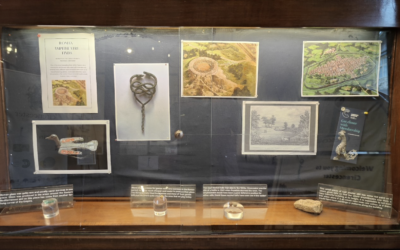


0 Comments